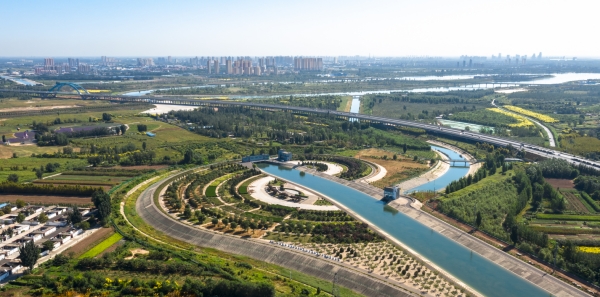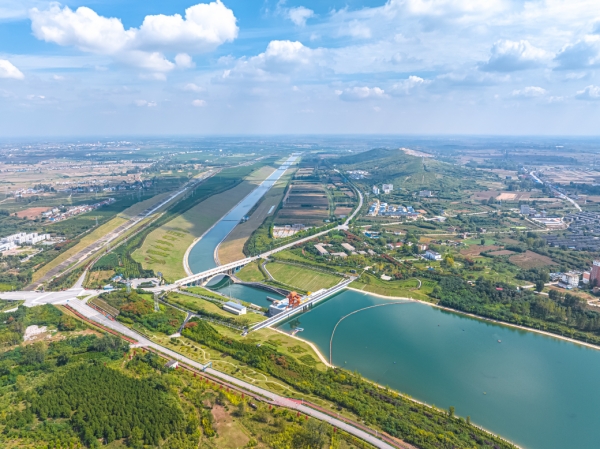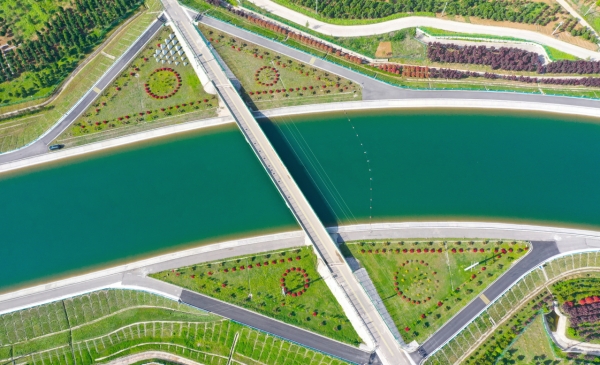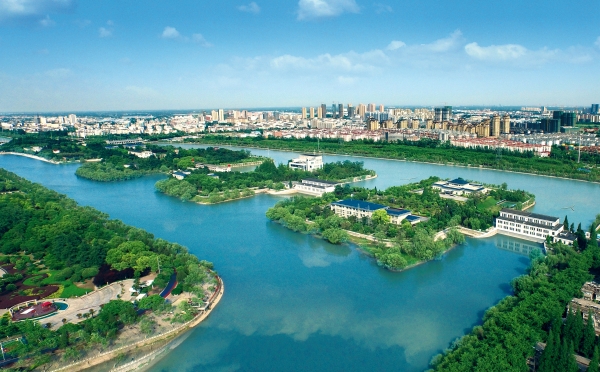China South-to-North Water Diversion Corporation, in collaboration with local governments, has been making significant progress in a major environmental restoration project that has the potential to guarantee the quality of water for much of the north of the country.
By fully leveraging the ecological benefits of the project, the corporation aims to contribute to the comprehensive management of groundwater over-extraction in North China, restoring river and lake ecosystems, and gradually unveiling a new vision of green ecological engineering for the new era.

The Hutuo River restoration project [Photo/sasac.gov.cn]
Systematic protection: Ensuring water quality

The Taocha Canal Headworks safeguards the transmission of clean water to north China. [Photo/sasac.gov.cn]
The success of the South-to-North Water Diversion Project hinges on water quality. During the initial construction of the first phase of the eastern route, Shandong and Jiangsu provinces prioritized the implementation of the pollution control plan, accelerating industrial structure optimization while advancing energy conservation and emission reduction.
To protect the water in the Danjiangkou Reservoir along the middle route, the State Council approved and implemented four 5-year plans for pollution prevention and control, and soil conservation in the reservoir and its upstream areas.
The corporation’s middle route company has established a comprehensive water quality monitoring system, consisting of one central hub, five water quality laboratories, 13 automated monitoring stations and 30 fixed monitoring sections, covering 123 water quality monitoring indicators.
The reappearance of the "peach blossom jellyfish," often referred to as the "giant panda of the water", in the Yizhuang Regulation Pool in Beijing in 2022, underscores the project’s success to date in the area of water quality.
Ecological transformation of rivers and lakes
Since its establishment, China South-to-North Water Diversion Corporation says it has been guided by the concept of harmonious coexistence between humans and nature. The first phase of the middle route has facilitated ecological recovery through water source substitution and the utilization of flood resources during the rainy season.
In 2021, the middle route project enabled the Yongding River to achieve full flow for the first time in 25 years, reconnecting it to the sea and restoring its status as a “flowing river.” The once-dry Hutuo River in Shijiazhuang now boasts expansive water surfaces, complemented by seven themed parks and 32 scenic spots. Additionally, Baiyangdian Lake has retained a consistent water level of around seven meters, with its surface area reaching 275 square kilometers, restoring the lake to its former glory.

A bird’s eye view of the middle route project in Yexian county [Photo/sasac.gov.cn]
Following the completion of the first phase of the eastern and middle route projects, local governments have adopted measures such as water source substitution, reduction of groundwater extraction and the sealing of self-prepared wells. These efforts have effectively halted the decline in groundwater levels, leading to a gradual recovery in the local environment.
In North China, after over 40 years of continuous decline, groundwater levels have not only stabilized but have also shown an overall upward trend.
The Beijing-Hangzhou Grand Canal, which had faced severe issues due to water scarcity and ecological degradation, has seen significant improvement. The extension project of the eastern route has cumulatively replenished 571 million cubic meters of water to the Grand Canal, making it the second “golden waterway” in China after the Yangtze River.
Comprehensive management: Forming a circular ecological chain
The South-to-North Water Diversion Project serves as the main artery of the national water network.
The first phase of the middle route has actively promoted the construction of green ecological belts, integrating engineering architecture, with the surrounding landscape, local culture and tourist attractions. The initiative has completed 1,200 kilometers of shelterbelt and greening projects, covering over 60,000 mu (approximately 4,000 hectares).
In the Danjiangkou Reservoir area, extensive soil and water conservation efforts have been undertaken. The forest coverage rate in Xichuan county, Henan province, has reached 53.2 percent, while in Shiyan city, Hubei province, it has reached 64.72 percent, achieving green, low-carbon circular development.
Ecological improvements along the water diversion route have also created more favorable conditions for wildlife. Jiaozuo, once a coal city blackened by soot, is now a sea of green, attracting migratory birds from late November to March each year.
At the Miyun Reservoir, which receives reverse regulation supply from the middle route project, the bird-watching team identified over 300 water birds from more than 20 different species in a few days, including 14 species of national first-class protected birds and 37 species of national second-class protected birds.
Model development: Building a "green project"
The Yangtze River to Han River Water Diversion Project stands as a key landmark in the overall development of the South-to-North project and the accelerated construction of the national water network’s main artery.
China South-to-North Water Diversion Corporation says it has embedded the concept of green development in every aspect of the Yangtze River to Han River project, striving to create a model of modern ecological water conservancy.

The first stage of the eastern route project, Jiangdu Water Conservancy Hub [Photo/sasac.gov.cn]
The company says it strictly enforces environmental protection measures and the principle of “simultaneous design, simultaneous construction and simultaneous commissioning” for the main project.
The company also says it continues to develop new energy sources tailored to local conditions, promote energy corridors along water diversion channels and advance integrated water diversion and energy storage projects. These efforts can contribute to green water diversion and reduce carbon emissions.
Looking ahead, the company says it will further improve its green and low-carbon development mechanism, comprehensively promoting the high-quality development of the South-to-North Water Diversion project and the national water network, making significant contributions to the construction of a beautiful China.
(Executive editor: Zhu Zeya)